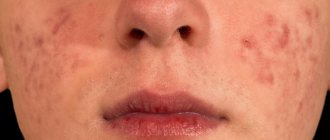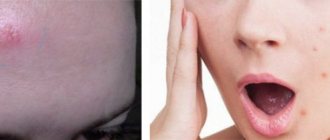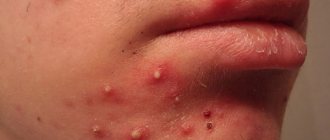- Causes of unpleasant odor from acne
- Subcutaneous pimple with an unpleasant odor
- How to get rid of acne with an unpleasant odor
According to the American Academy of Dermatology and Acne, acne is the most common and complex inflammatory skin disorder, affecting at least 50 million American adults and teenagers. The inflammatory condition involves problems with the skin's sebaceous glands, which become clogged with dead skin cells and excess oil, trapping bacteria in pores This causes an inflammatory response and leads to the development of pimples, some of which contain pus. Pus can emit a foul odor due to the byproducts of bacteria feeding on the skin's oil.
Causes of unpleasant odor from acne
Acne - bacteria
A type of bacteria called Propionibacterium acnes (P acnes) usually lives deep in the oily pores of the skin because it feeds on the skin's oil, also known as sebum. People with acne usually have an overgrowth of P acnes, likely due to excess sebum production. People with acne also have an exaggerated immune response to P acnes, which leads to inflammation of the pores and a buildup of white blood cells. An inflammatory response to trapped bacteria, as well as a buildup of sebum, dead skin cells, and white blood cells in the pores, leading to the appearance of pus. People with moderate or With severe acne, these pimples can grow into larger nodules or cysts and even develop an unpleasant pimple odor.
Odor associated with bacteria:
Many types of bacteria produce odors as they grow. These odors come from the by-products produced by the bacteria feeding on various substances. P acnes has specialized enzymes that allow the bacteria to break down and feed on sebum. This breakdown results in the formation of propionic acid and chemicals called short-chain chemicals. fatty acids While sebum is odorless, side effects from the breakdown of sebum oil P acnes release an odor that many patients describe as a bitter or sour body odor.
Types of Bacteria that Infect a Pimple and Cause Bad Odor
There are different types of bacteria that can harm hair follicles, causing clogged pores that can result in zits. These different types of bacteria have a completely different effect on how these odors smell. Aerobic bacteria, which depend on the growth of oxygen, usually do not cause a foul smell with rot. zit, while those anaerobic bacteria that produce sulfur can cause zit to smell bad.
Bacteria are usually present on the skin, and some of them are beneficial. But harmful bacteria, such as Staphylococcus aureus, may also be present. Blocked pores provide a breeding ground for bacteria and can become infected as the bacteria attack the biological building materials in them. The odor is unlikely to be very noticeable. If the smell is very noticeable, then this may indicate a more serious infection, and you should consult a doctor as soon as possible.
Pimple pus smell
When small, common pimples produce a small amount of pus, it is unlikely that you will notice any odor. In this case, the amount of odor-producing chemicals is usually too low to cause a noticeable odor. However, because large nodules of dead cells and cysts contain a large amount of pus and bacterial debris, you may notice an unpleasant odor from these types of pimples as well.
Dead skin cells
As new skin cells develop in the dermis, old skin cells are forced out. The outermost layer of skin cells, the stratum corneum, is made up of about 20 layers of dead skin cells that gradually slow down. But in acne, dead skin cells can get trapped in the pores, and instead of peel off, they form a fork with sebum. They can begin to disintegrate in the pores, which contributes to the problem of foul-smelling pus from the pimple.
Although the foul odor caused by pus usually affects severely infected skin that contains a large amount of pus, it is not a major problem for your health. Instead of trying to determine what your pimple smells like, it is better to pay close attention to the symptoms of its development. skin disease and as accurately as possible in the future explain to the dermatologist the entire course of the disease.
How are gums treated?
Periodontitis therapy begins with the removal of plaque and tartar.
The use of local remedies relieves the problem only for a short period of time. The latent course of the inflammatory process continues, leading to an increase in the depth of periodontal pockets and increased destruction of the bone tissue adjacent to the element. An abscess in the mouth is a source of infection. The surgeon must open it up and remove the pus from under the tooth in the gum without pain. Infiltration anesthesia is used. The resulting wound is treated with antiseptic solutions. Drainage is used to prevent premature overgrowing and ensure the flow of contents.
Therapy in dentistry
Depending on the severity of the condition, drug or surgical treatment is chosen.
Conservative technique is a long and labor-intensive process consisting of several stages:
- Survey. The dentist studies the patient’s medical history and finds out when and under what circumstances a purulent formation appeared on the gum. It is important to know how quickly the pathology progressed.
- Clinical examination. The location, shape and color of the abscess are studied. If necessary, X-ray diagnostics of the diseased part of the jaw is performed. An image is required for an objective assessment of the state of the structure of internal tissues. The further method is chosen depending on the severity of the case.
- Disinfection of the oral cavity. Thorough removal of food debris, plaque and tartar. Antiseptics, painkillers and anti-inflammatory drugs are used.
- Treatment of purulent gums by creating an outflow of contents from the abscess. The medical procedure is performed at the Dentika clinic under local anesthesia. The surgeon carefully dissects the affected area and installs a drain into the created incision to cleanse the cavity of infected fluid.
Long-term use of anti-inflammatory drugs is required. To prevent re-formation of the infiltration site, antibiotics and local antiseptic rinses are prescribed.
Some patients are bothered by excruciating toothache and complaints that pus is released when pressing on the gums while chewing. At the same time, there is no lump on the jaw. In this situation, the scheme described above will be ineffective. Surgery is required. If there is a filling, the surgeon carefully removes it and cleans the canals, washing out purulent accumulations. A small area of inflammation allows for filling.
If a granuloma or cyst is present, a temporary filling is placed for 3 months. At the end of the specified period, an x-ray is taken. If positive dynamics are observed, filling and crown installation are performed.
Additional procedures
A qualified dentist will tell you how to treat your gums if a purulent sac bursts and pus appears, and will give recommendations for further care of your teeth and oral cavity. To increase the effectiveness of conservative therapy, most doctors prescribe a course of physiotherapeutic procedures: electrophoresis, ultrasound and laser techniques. After passing, positive dynamics are noticeable. If all medical recommendations are followed, there is a decrease in discomfort and swelling, and a general improvement in well-being.
Recovery
Many patients are wary of going to the dentist and wonder whether treatment for purulent gums can be painless. Dental invasive interventions are performed under anesthesia without discomfort for the patient. Despite this, opening and draining an abscess is additional stress for the body. To speed up healing, you should follow the recommendations:
- Follow medical instructions.
- Take prescribed medications.
- Protect yourself from stress.
- Eat a healthy and balanced diet.
- Avoid drinking alcohol and smoking.
- Perform daily hygiene procedures.
- Use irrigator, floss and dental rinse.
Compliance with the recommendations contributes to accelerated recovery and prevention of relapses.
Subcutaneous pimple with an unpleasant odor
Poll: When did your acne appear? (Number of votes: 4295)
I've been suffering all my life
It's been a couple of years now
About a few months
Recently
To vote, click on the desired answer. results
A subcutaneous pimple with an unpleasant odor usually appears as a sebaceous cyst - a small lump of oil and pus located under the skin. This type of cyst is not cancerous.
They most often occur on the face, neck, and upper back, but can occur on other areas of the body.
Typically, a sebaceous cyst grows very slowly and does not cause pain.
However, they can become inflamed or infected, with the overlying skin becoming red, tender and painful to the touch.
How to get rid of acne with an unpleasant odor
Most recommended acne treatments directly or indirectly reduce the overgrowth of P. acnes in the sebaceous glands, thereby reducing the likelihood of foul-smelling pus. Topical benzoyl peroxide products, for example, kill some of the P. acnes on the skin.
These products are recommended for use either alone or in combination with other acne treatments Oral antibiotic therapy also reduces P. acnes populations and is recommended for some people with acne Topical retinoids such as tretinoin (Retin-A), adapalene (Differin) and tazarotene (Tazorac ), in the form of a gel or lotion.
Zits, or foul-smelling pimples, are usually more common in men, although women can experience them too. Although this skin breakout usually occurs on the facial skin, zits can also spread throughout the skin of the body. Zits are always filled with pus, which is usually solid white or yellow. color Pus is dead white blood cells that fight off infecting bacteria. As anaerobic bacteria, these bacteria do not require oxygen to survive. Instead, they produce their own sulfur compounds when they grow and spread through the internal channels of the skin.
A strong odor may be noticed if the zit is infected with an anaerobic type of bacteria. On the other hand, bacteria growing and spreading with oxygen usually does not cause a foul odor. A mild zit problem usually does not lead to that foul odor, while a severe infection tends to result in an odor. , as the body produces more of the pus contained in the zits.
The stronger the odor, the more likely the zit will be contagious. This means that if you detect a foul odor, the infecting bacteria will enter other skin pores, causing another similar pimple. Therefore, it is important to clear any purulent zit to prevent further infection and bacterial infestation Therefore, it is important to clean any purulent abscess to prevent further spread of infection and bacterial infestation.
Is it possible to cure an abscess at home?
Patients with acute conditions are admitted to dentistry without a queue. Therefore, if your health worsens, you should not postpone your visit.
The first question that a patient has is: why does pus appear in the gums and how to treat the pathology? The cause of infiltration is a weakened immune system and non-compliance with dental care measures. At the first symptoms of inflammation, you should immediately consult a dentist. Self-opening of a flux neoplasm threatens the addition of a secondary infection.
It is strictly forbidden to heat the inflamed area. Heat activates purulent-necrotic processes and accelerates the spread of infectious agents.
Timely sanitation of the inflammatory focus in a clinical setting prevents complications.










